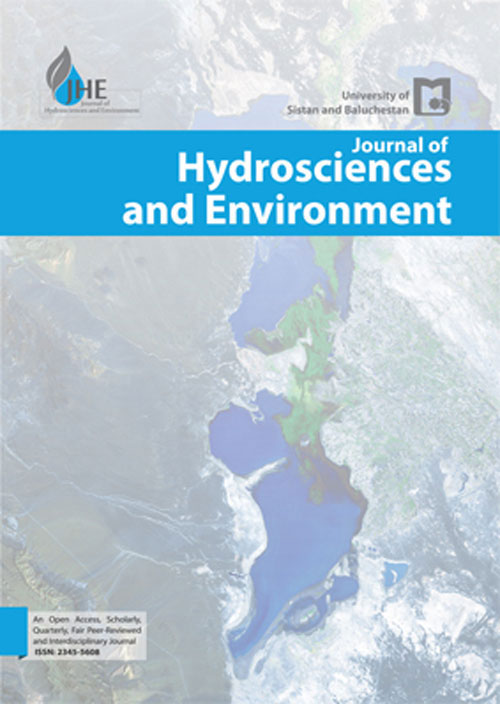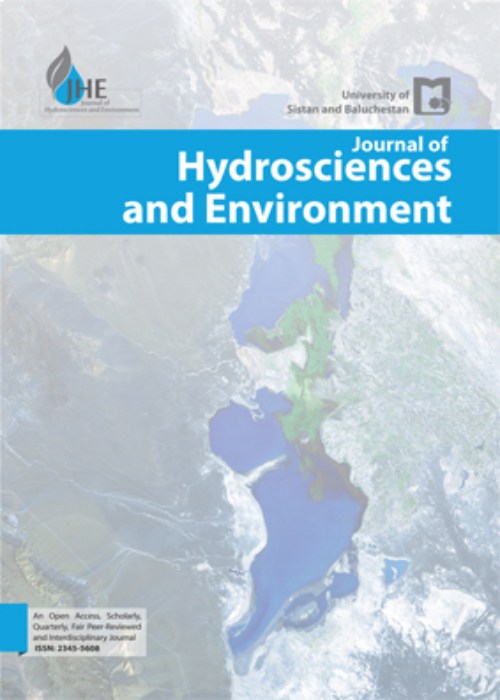فهرست مطالب

Journal of Hydrosciences and Environment
Volume:4 Issue: 8, Dec 2020
- تاریخ انتشار: 1401/04/01
- تعداد عناوین: 6
-
Pages 1-13
Today Land use change is one of the most important challenges facing the agricultural sector, And Conservation of agricultural lands is an important goal worldwide. So the aim of this study was to design a model for the protection of agricultural land use using structural equation modeling, this research has been done in Hamedan province. The statistical population of the study is the total number of farmers in the province (N = 117571). That 384 people were selected from this population using Krejcie and Morgan table as a sample by multi-stage sampling method. The main research tool is a researcher-made questionnaire for collect and analyze the required data. The reliability of the questionnaire has been confirmed by Cronbach's alpha and its validity by a group of experts in the field of agricultural extension and sustainable development. Based on research results It is necessary to pay attention to six social, economic, access, regional, policy and technical-agricultural strategies for the protection of agricultural lands. also Friedman test showed, also The use of Friedman test showed Technical-agricultural solutions are the first priority for the protection of agricultural lands. Showed the use of structural equation modeling to fit the model There is a good correlation between each factor and its related indicators. Based on research results Increase the economic efficiency of the agricultural sector and make this sector competitive with other economic sectors And Increasing the economic power of farmers is the most important factor in the protection of agricultural lands.
Keywords: Agricultural Land use, Land Conservation, land use change, Hamadan Province -
Pages 14-20The application of dynamic and continuous time series has drawn attention due to the complexities of the rainfall-runoff process and the simplification of multiple regression and static methods. On the other hand, forecasting river flow is one of the main topics in flood control. This paper reports the results of applying the SWAT hydrological model to analyze the rainfall-runoff relationship for a 6-year period in the Kahir catchment basin, Sistan and Baluchistan province. The model output was calibrated by the SUF12 optimizer algorithm, and the data entered the model again. Then, the model output was used to forecast future periods using Support Vector Regression (SVR) and essential codes in MATLAB. The acceptable results of the SVR model regarding data prediction can be used as another method to estimate parameters and inputs.Keywords: SWAT hydrological model, Support Vector Regression (SVR), Time-series forecast, Kahir River
-
Pages 21-33The threat of climate change over the past decades has become more prominent among environmental experts. As a result, economists and environmental researchers are more likely to pursue environmentally-friendly economic growth. The present study examines the variables of open trade, population, GDP, and its square to study the Kuznets environmental hypothesis regarding carbon dioxide, methane, and nitrogen oxide emissions in three separate equations, which have, to the authors’ best knowledge, been rarely addressed in the literature. The study period was from 1990 to 2016 conducted on 20 countries in the Asian Productivity Organization (APO). This hypothesis has not been studied regarding air pollution among APO members states. The panel ARDL method was used regarding the panel data applied for the structure of the research data. According to the results, the Kuznets environmental hypothesis was approved as reversed U for carbon dioxide and methane gases in the long run, but not for nitrous oxide. The short-term results also indicate the rejection of the Kuznets environmental hypothesis among the studied countries. The variable of trade had a negative correlation with the emission of all three greenhouse gases. Also, the earning elasticity estimated for CO2, N2O, and CH4 at 0.4, 0.38 and 0.04, respectively show that the effect of GDP growth on CO2 emissions is higher than that of N2O and CH4 emissions, indicating the importance of CO2, which causes more air pollution than other greenhouse gases and will have an important impact on the quality of the environment. Therefore, it is recommended to consider more measures for curbing carbon dioxide than for other greenhouse gases to prevent its emissions.Keywords: Carbon dioxide, Kuznets hypothesis, Nitrogen oxides, Asian Productive Countries, Methane, Panel ARDL
-
Pages 34-47Gravity current is the flow of fluid through another fluid of varying density. This flow often occurs in nature. For optimal management of water resource quality, it is necessary to know and study the gravity current. Naturally, many streams have a meandering path. There are also many blocks in different shapes (both natural and artificial). Therefore, in the present study, to control a lock-exchange gravity current, a triangular, rectangular, or trapezoidal rigid barrier was placed inside a curved channel with a curvature of 120 degrees and a radius (R) of one meter. Simulations were performed using the OpenFoam open-source software and the realizable k-ɛ turbulence model. The Reynolds number was 19700 in all of them. According to previous studies, in a block-free channel, the most secondary current occurs in the middle of the curve. In this study, to control the secondary current, the blocks were placed at 60 degrees of the curve. With an impediment, the secondary current was visible in the body and tail of the current but did not occur in the current head. The obstacle affected the pattern of the secondary currents so that the pattern was different around the block from the other locations. The barrier also reduced the spanwise velocity of the flow body. The concentration was maximum at the head of the stream, indicating that the barrier could affect the concentration along the stream so that the maximum concentration was behind the block. The current head was also affected by the block, as it did not advance for a moment on the inner bank; at these moments, the outer bank surpassed the inner bank.Keywords: OpenFOAM, Curved Channel, Gravity Current, Block, lock, Exchange
-
Pages 48-59The flow caused by a dam break usually develops towards the river or the plain flood. The downstream of the dam is usually a natural river where the bed is mobile and significant amounts of bed sediments are transferred downstream due to the non-continuous flow caused by the flood. Accurate prediction of complexities, involved in such a multiphase water-sediment system is still an important challenge for conventional mesh-based numerical models. Numerical methods, based on mesh-free Lagrangian approaches including Smoothed Particle Hydrodynamic )SPH (and Moving Particle Semi-implicit method (MPS), have provided a unique opportunity to deal with the deformation and fragmentation in these complex multiphase systems. This study develops and evaluates a mesh-free Lagrangian model based on a weakly-compressible MPS formulation for the simulation of two-phase rapid sediment transport. To model non-cohesive sediments, the sediment material is considered a non-Newtonian visco-plastic fluid, and an exponentially-regularized Herschel-Bulkley (H-B) rheological model in combination with Mohr-Coulomb yield criteria is employed. The capability of the developed numerical method is evaluated for two-phase sediment transport in a dam break on an erodible bed. Dam break flow over an erodible sediment bed for two geometrical setups (with dry and wet downstream) is considered. The comparison of the results with the available experimental measurements showed the capabilities of the proposed model in the accurate prediction of sediment and water profiles for this sample problem.Keywords: Moving particle semi-implicit method, Multiphase model, Exponential Herschel-Bulkley model, Erodible-bed dam break
-
Pages 60-66
DNA extraction is one of the first tasks in the genomic study, and finding an effective protocol for the isolation of DNA is essential in genetic engineering and most microbiology studies. DNA extraction from microalgae has always been a challenge for microbiologists due to their tough and complex cell walls and inhibitory substances in their cellular structures. Also, inefficient or differential DNA extraction of microalgae community members can lead to bias in downstream community analysis; therefore, pure DNA extraction for molecular studies is of particular importance. In this study, the efficacy and experimental variability of two modified protocols (Phenol/Chloroform’s method, and dellaporta DNA extraction’s method) for total genomic DNA extraction from four microalgae were studied. The selected microalgae for this study were Dunaliella salina, Haematococcus pluvialis, Nannochloropsis oculata, and Spirulina platensis. The concentration of DNA was measured using Nanodrop and agarose gel electrophoresis. Both modified and optimized methods used in this study showed reliable and effective results and can be recommended for future studies; However, the results indicated that optimized phenol/Chloroform’s method is preferable to the dellaporta DNA extraction’s method. The highest obtained amount of DNA was related to Dunaliella salina (815.1 and 506.8 ng/μL) in phenol/Chloroform and dellaporta DNA extraction’s method, respectively; and the lowest amount was related to Spirulina platensis with concentration 112.4 ng/μL (in Phenol/Chloroform’s method) and 30.5 ng/μL in dellaporta DNA extraction’s method. The extracted DNA was free from protein and polyphenolic/ polysaccharide compounds, therefore, they are recommended to all molecular studies on Microalgae.
Keywords: DNA Extraction, DNA Isolation, Dunaliella salina, Haematococcus pluvialis, Nanochloropsis oculata, Spirorulina platensis


